Let’s go to the famous tourist attraction in early morning!! “Part.4” is ・・・ Yasaka-jinja Shrine!!
Yasaka-jinja Shrine(Kyoto) is the head shrine of other Yasaka-jinja Shrine which is about 2300 in Japan.
This Shinto shrine was called “Gion-jinja Shrine” in the old days.
Therefore this shrine is called “Gion-san” by local people now.
In addition, the Gion festival that is one of the Japan’s three biggest festivals is held every July in this Shinto shrine.
Besides, 1 million worshipers visit this Shinto shrine at the time of the New Year’s visit to a Shinto shrine of New Year holidays.
(The number of worshipers of the New Year’s visit to this Shinto shrine is the second in Kyoto. The first place is Fushimiinari-taisha Shrine.)
And this shrine is designated as the Michelin green guide ★.
However ・・・,
This shrine is too famous and is also crowded very much every day.
If you go to this shrine with much effort,
“I want to see the sights slowly in the time when it is not crowded!!”
“I want to take the clean photograph which other person does not appear in!!”
・・・, Don’t you think in this way?
I have some good news for you!!
I visited to see whether Yasaka-jinja Shrine at the early morning is not really crowded.
Contents:
- Is early-morning Yasaka-jinja Shrine really not crowded?
- About Yasaka-jinja Shrine
- The highlights of Yasaka-jinja Shrine
- Many sub-shrines of Yasaka-jinja Shrine
- Maruyama-koen Park near Yasaka-jinja Shrine
- Goshuin(The stamp that is given at a shrine/temple) of Yasaka-jinja Shrine
- How to get to Yasaka-jinja Shrine
1.Is early-morning Yasaka-jinja Shrine really not crowded?
Answer : “not crowded” (until around 7:30 a.m.)
But, please be careful because a tourist and the school excursion student of the group visit this temple when it is past 8:00 a.m.
By the way, Yasaka-jinja Shrine opens for 24 hours.
(The shrine office opens from 9:00.)
I visited to Yasaka-jinja Shrine on the first train. I was very sleepy… (*´・ェ・`*)
I arrived at the the west Romon Gate(Nishi-Romon) which is the entrance of this shrine at 6:30 a.m. !!
There is no one on the gate!!

There is no one on the Main Hall(Honden)!!

Oh, I was very satisfied. d(*゚ー゚*)
2.About Yasaka-jinja Shrine
Yasaka Shrine (八坂神社 Yasaka-jinja), once called Gion Shrine (祇園神社 Gion-jinja), is a Shinto shrine in the Gion District of Kyoto, Japan. Situated at the east end of Shijō-dōri (Fourth Avenue), the shrine includes several buildings, including gates, a main hall and a stage.
引用(citation):https://en.wikipedia.org/wiki/Yasaka_Shrine
Open:24 hours(The shrine office opens from 9:00.)
Admission Fee:Free
Adress:625, Giommachi Kitagawa, Higashiyama-ku Kyoto-shi, Kyoto, 605-0073, Japan
Phone Number:+81-75-561-6155
This Shinto shrine which was built in 656 years has the history more than 1,300 years.
This Shinto shrine was called “Gion-jinja Shrine” in the old days.
Therefore this shrine is called “Gion-san” by local people now.

3.The highlights of Yasaka-jinja Shrine
This is the west Romon Gate(Nishi-Romon).
(The official gate of this Shinto shrine is not this gate but the south Romon Gate(Minami-Romon).)
(The south Romon Gate is during restoration construction now. It is going to be completed in March, 2017.)

The west Romon Gate is an important cultural property of a country which was rebuilt in 1497.
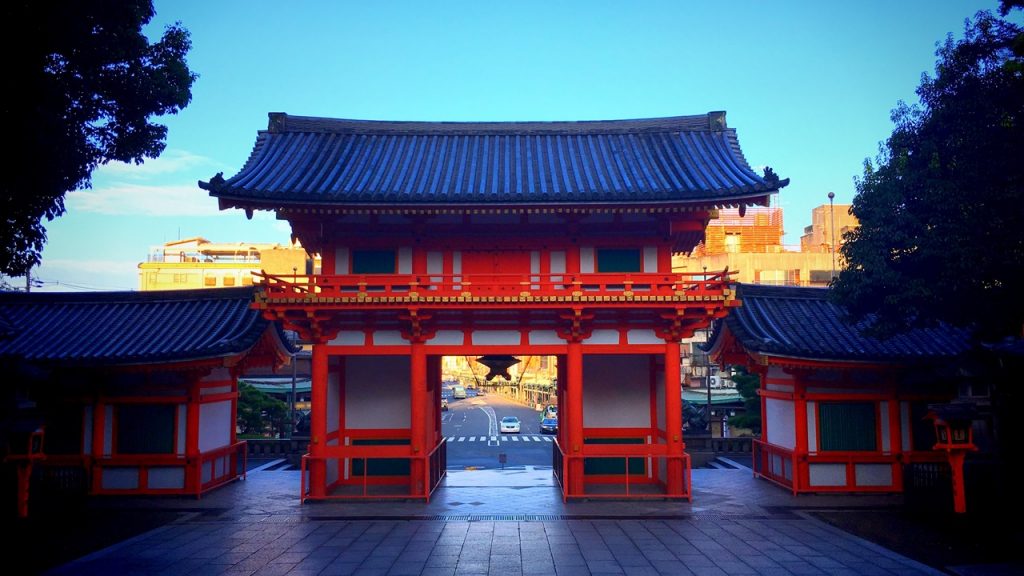
This is a pair of stone guardian dogs in front of the west Romon Gate.
The left pair of stone guardian dogs is magnificently horned dog.


This is the Chozuya in the west gate.

This shrine is appointed to the special historic natural features conservation zones by Kyoto-shi.

This is the Main Hall(Honden).

In the Main Hall(Honden) of this Shinto shrine, a Main Hall and a Worship Hall(Haiden) become the same building unlike other Shinto shrines.
This architecture is called the Gion-zukuri style.
(A Main Hall(Honden) and a Worship Hall(Haiden) are separate buildings in the case of other Shinto shrines.)

The Main Hall(Honden) has been donated by Ietsuna TOKUGAWA who is 4th General of the Edo Shogunate.
In addition, this building was rebuilt in 1654, and has been appointed to an important cultural property of a country.
(The current building is repaired in 2002.)

“Susanoo-no-mikoto“, “Kushiinadahime-no-mikoto” and “Yahashira-no-mikogami” which is the main enshrined deity is enshrined in the Main Hall(Honden).

“Susanoo-no-mikoto” is famous as God who exterminated “Yamatano-Orochi(eight-forked-snake)” in a Japanese myth.
And “Susanoo-no-mikoto” married “Kushiinadahime-no-mikoto” thanks to this myth.
And eight children of this couple are “Yahashira-no-mikogami”.

This is the Stage (Maidono) which is built in front of the Main Hall(Honden).

The Stage(Maidono) is the building where various dedication events or wedding ceremonies are held.

Approximately 300 lanterns which was dedicated by a believer are hung to the Stage(Maidono). (○´艸`)

This lanterns are lit up in the night. d(*゚ー゚*)

This is the Chozuya of the south Romon Gate(Romon) which is the official entrance of this Shinto shrine.
(The south Romon Gate is during restoration construction now. It is going to be completed in March, 2017.)

This is the storage of miniature shrine.
A miniature shrine used by the Gion festival is kept in this building.

This is the Shinto priest-purification shelter(Saikan).
This building is a place to cleanse mind and body before a Shinto priest performs Shinto ritual.

This is the noh stage added to the Shinto priest-purification shelter(Saikan).
On this noh stage, a karuta(traditional Japanese playing cards) festival is held every year on January 3.
“Susanoo-no-mikoto” who is the enshrined deity of this Shinto shrine is God who wrote a 31-syllable Japanese poem in a Japanese myth for the first time.
“八雲立つ 出雲八重垣(いづもやえがき) 妻籠みに 八重垣作る その八重垣を“

This is a shrine office.
The shrine office opens from 9:00.

This is the Ema-do hall.
Various Ema(a votive horse tablet) which was dedicated by a believer are displayed in this building.

4.Many sub-shrines of Yasaka-jinja Shrine
There are many sub-shrines in the precincts of Yasaka-jinja Shrine.
Each sub-temples have different divine favor.
There are sub-temples of Yasaka-jinja Shrine in “the east area”, “the west area”, and “the north area” of the main shrine.
●East area

This is the Utsukushigozen-Sha. Because there is divine favor of the beauty in this sub-shrine, it’s very popular with women.
“Tagirihime-no-mikoto“, “Tagitsuhime-no-mikoto” and “Ichikishimahime-no-mikoto” who are said to be God of the beauty is enshrined in this sub-shrine.

This is the sacred water which is said to the water of beauty gushing out of this sub-shrine.
It is said that we grows beautiful when we add this water to skin. d(*゚ー゚*)
*By the way, this water is not drinking water. Please do not drink this water.

The wish of many women is dedicated to this sub-shrine.

This is the Akuojisha(the ara-tama of Susanoo-no-mikoto).
The word called “悪(Aku)” of this sub-shrine has a meaning of “powerful”.
Therefore this sub-shrine has divine favor of “Dreams will come true“.

This is the Tadamori’s lantern.
This is the lantern showing bravery of TAIRA no Tadamori in the one paragraph of the Heike Monogatari.

This is the Inari-sha Shrine.
This sub-shrine is the sub-shrine where two sub-shrines of “Tamamitsuinarisha” and “Myobuinarisha” became one.

The pair of stone guardian of this sub-shrine is not a dog but a fox.
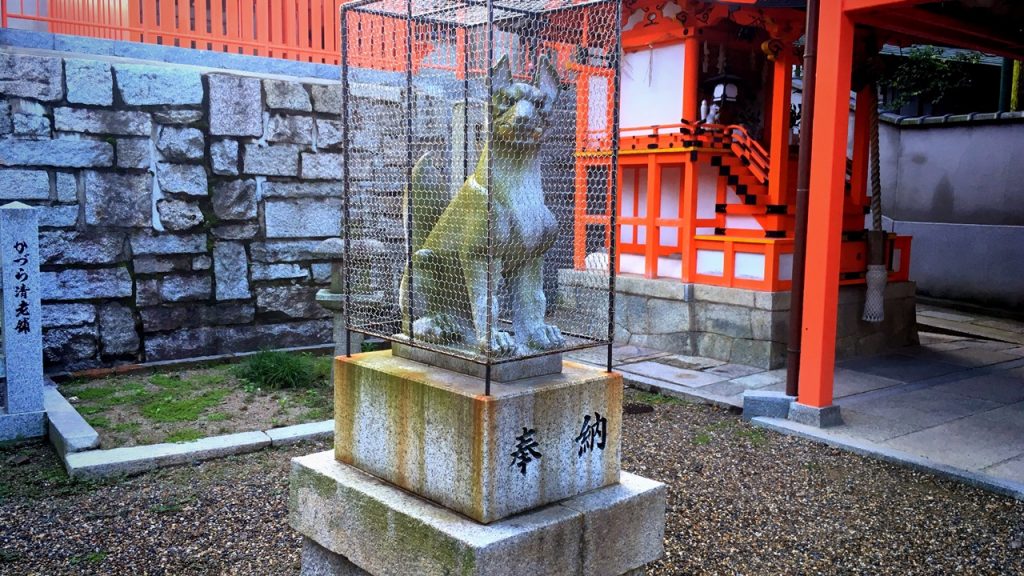
●West area

This is the Eki-jinja Shrine.
Somin Shorai is enshrined in this Shinto shrine, and there is the divine favor of the sound health.
Somin Shorai is poor but a gentle person who appear in a Japanese myth.

This is the Ota-sha shrine.
“Sarutahiko-no-kami” and “Ame-no-uzume-no-mikoto” are enshrined in this Shinto shrine, and there is the divine favor of the marriage and the entertainment.

This is the Kitamukiebisusha (Kotoshironushi-no-mikoto).
This sub-shrine is facing north. (The Shinto shrine which is facing north is very rare.)
Kotoshironushi-no-mikoto is enshrined in this Shinto shrine, and there is the divine favor of the business prosperity.

“Kotoshironushi-no-mikoto” and “Ebisu who is one of the 7 gods of happiness” are the same god.
Therefore this sub-shrine is also called “Ebisu of Gion“.

This is the Okuninushisha.
Okuninushi-no-mikoto is enshrined in this sub-shrine, and there is the divine favor of the marriage.
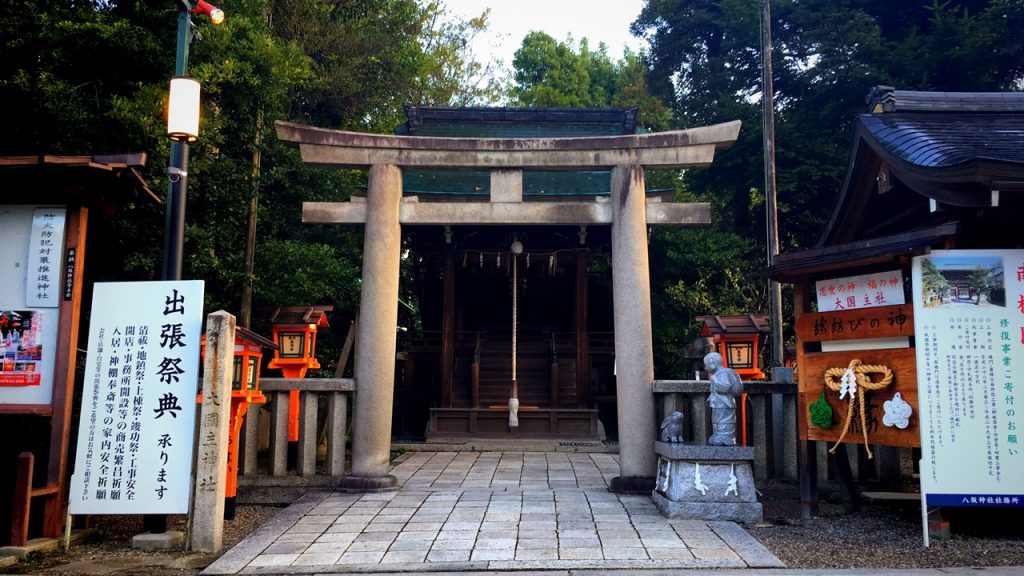
“Okuninushi-no-mikoto” is God who is also called “Daikoku-sama” in Izumo.
In addition, this God is famous for the episode of the white rabbit of Inaba.

This is the Otoshisha.
“Otoshi-no-kami” and “Chimatayashiro-no-kami” are enshrined in this sub-shrine, and there is the divine favor of the huge harvest.

This is the Jussha where 10 small altars became one big altars.
This is an apartment of God when I say in contemporary style…? (*´・ェ・`*)

This is the stable of the horse dedicated to the shrine.
Vermilion and a white wooden horse are enshrined in this building now.

●North area

This is the Hiyoshisha.
“Omononushi-no-kami” is enshrined in this sub-shrine, and there is the divine favor of the protection for removing calamities related to direction.
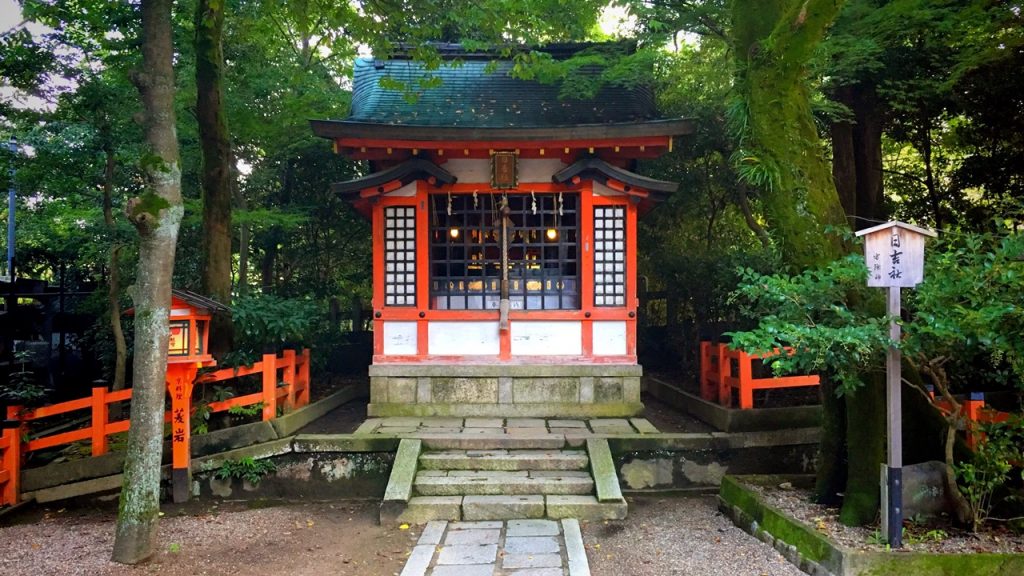
A building on this side is the Hamono-jinja Shrine.
“Amanomahitotsu-no-kami” is enshrined in this sub-shrine, and there is the divine favor of the good-luck.
The word “Hamono” has the meaning of the cutlery/knife.
(It is said that it is possible to explore the future with the cutlery/knife.)
A building on the other side is the Gosha where five small altars became one big altars.

This is the Sorei-sha Shrine.
“Spirits of the person concerned of Yasaka-jinja Shrine” are enshrined in this sub-shrine.
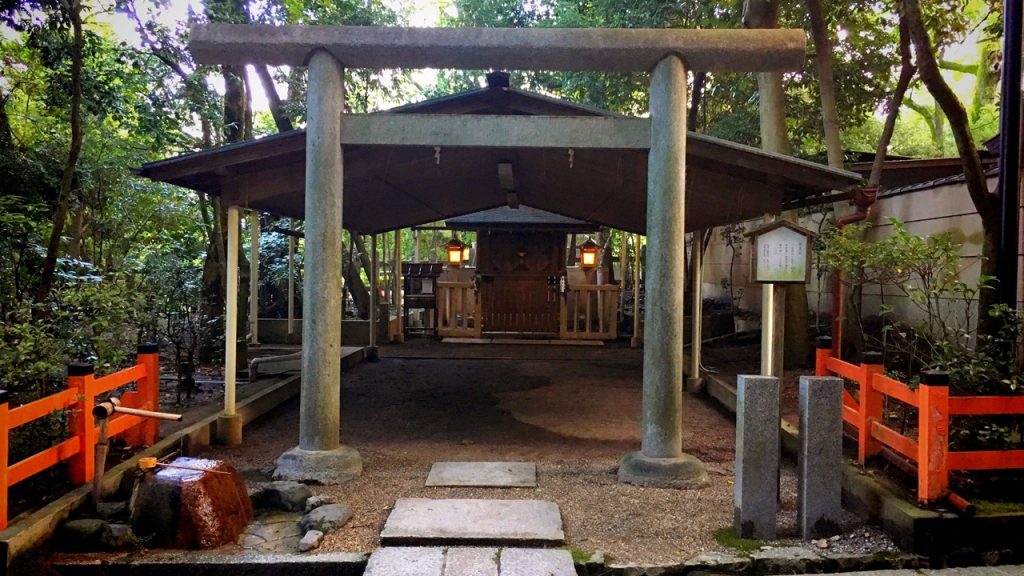
This is the Itsukushimasha.
“Ichikishimahime-no-mikoto” is enshrined in this sub-shrine, and there is the divine favor of the child care.

5.Maruyama-koen Park near Yasaka-jinja Shrine
There is Maruyama-koen Park on the east side of Yasaka-jinja Shrine.
Maruyama-koen Parkis is designated as the natural beauty spot of the country.

This is the Gion-Shidarezakura(very big cherry tree) which is a symbol of Maruyama-koen Park.
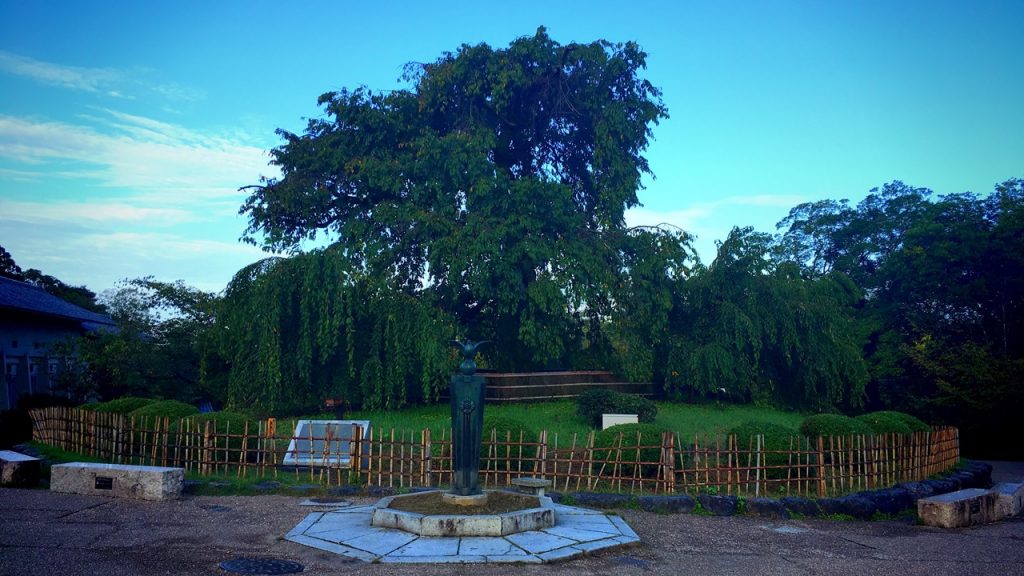
A lot of cherry blossoms bloom there in the spring. d(*゚ー゚*)
引用(citation):http://k-kabegami.sakura.ne.jp/arasiyama/11.html
A part of this park has become a type of Japanese garden with a pond in the centre.

Let’s take a break in Maruyama-koen Park if tired from sightseeing.

6.Goshuin(The stamp that is given at a shrine/temple) of Yasaka-jinja Shrine
The word which can read as “祇園社(Gionsha)” is written to Goshuin with a sumi.
“祇園社(Gionsha)” is the old name of Yasaka-jinja Shrine.

7.How to get to Yasaka-jinja Shrine
The nearest station of Yasaka-jinja Shrine is “Keihan Gion-shijo Station” or “Hankyu Kawaramachi Station”.
The nearest station of Yasaka-jinja Shrine is “Keihan Gion-shijo Station” or “Hankyu Kawaramachi Station”.
■Route Example (From Osaka Station to Keihan Gion Shijo Station)
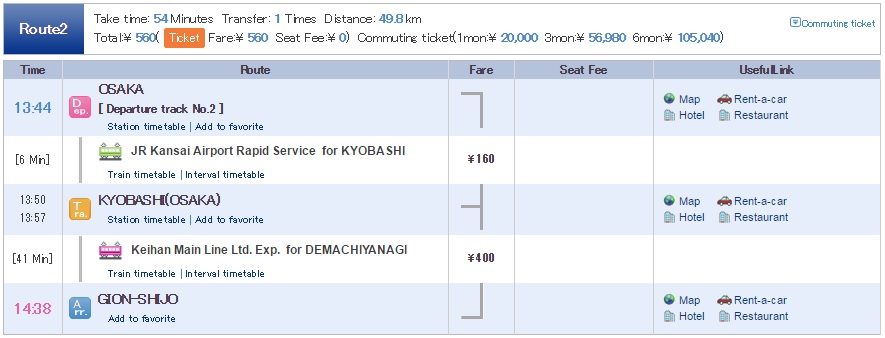
■Route Example (From Namba Station to Keihan Gion Shijo Station)

■Route Example (From Kyoto Station to Keihan Gion Shijo Station)

■Keihan Gion-shijo Station/Hankyu Kawaramachi Station→Yasaka-jinja Shrine

How did you like it?
Please try to go.
Have a nice trip! XD
<Let’s search the sightseeing information of Kansai in Japan on ‘Japan’s Travel Manual‘!!>
<This site introduces the easiest way to get Japanese (Kansai) sightseeing spots to you.>




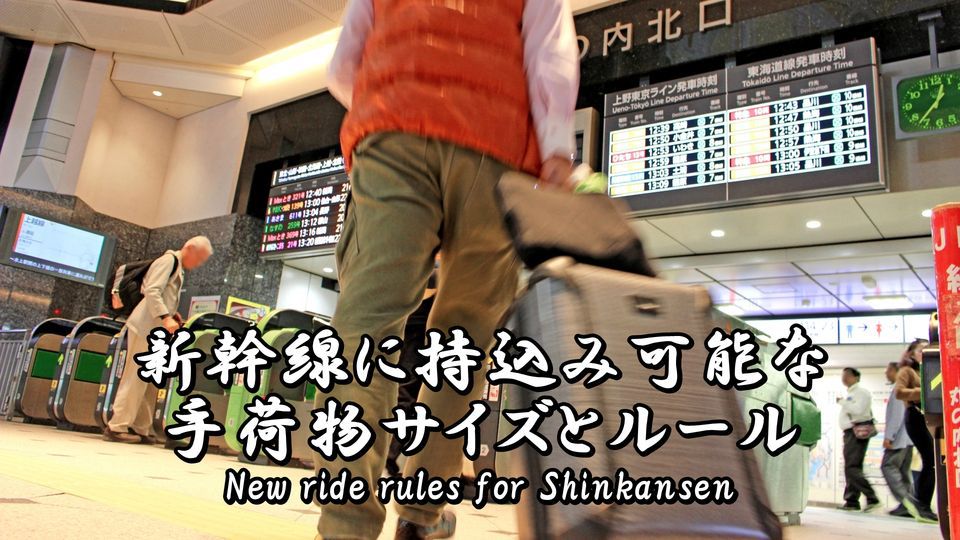





Thank you for this excellent guide and very useful practical information. I have been to Kyoto four times but never to Yasaka-jinja. Next time I am in Kyoto I will definitely visit this shrine.